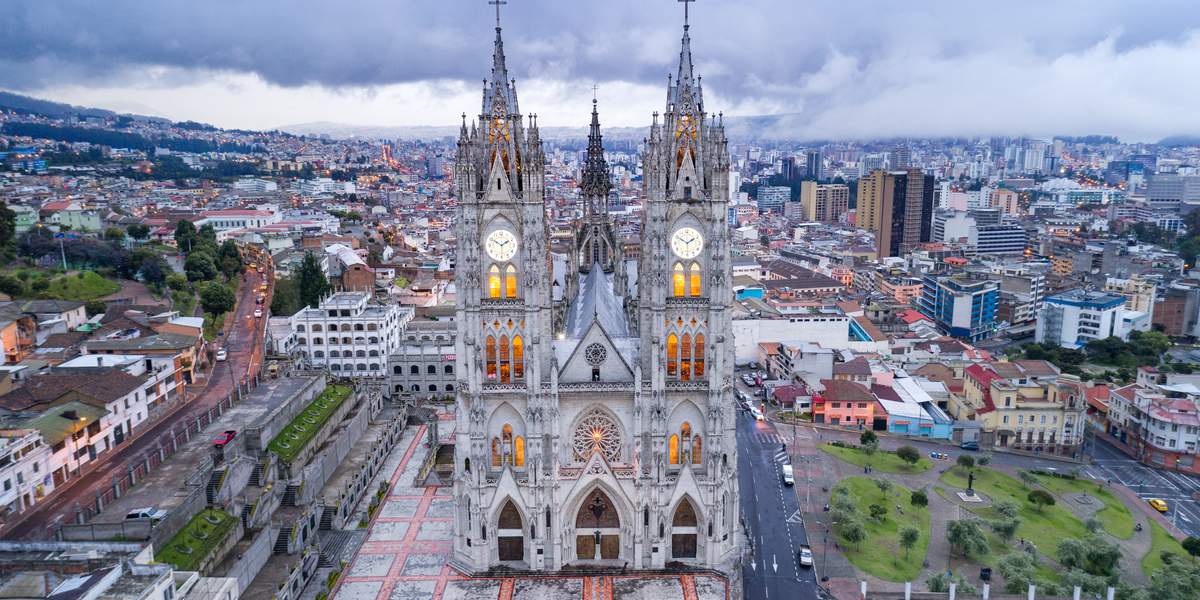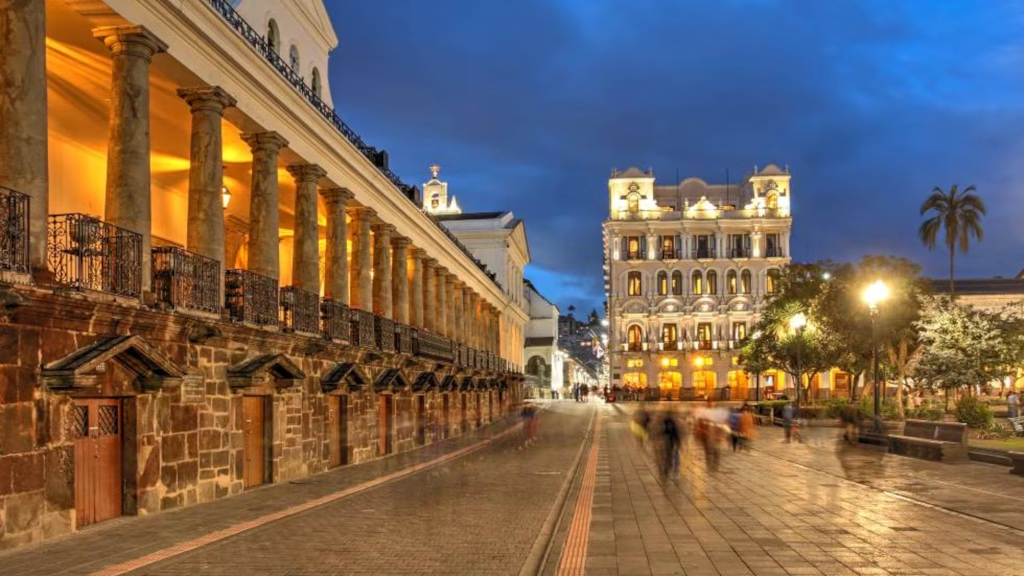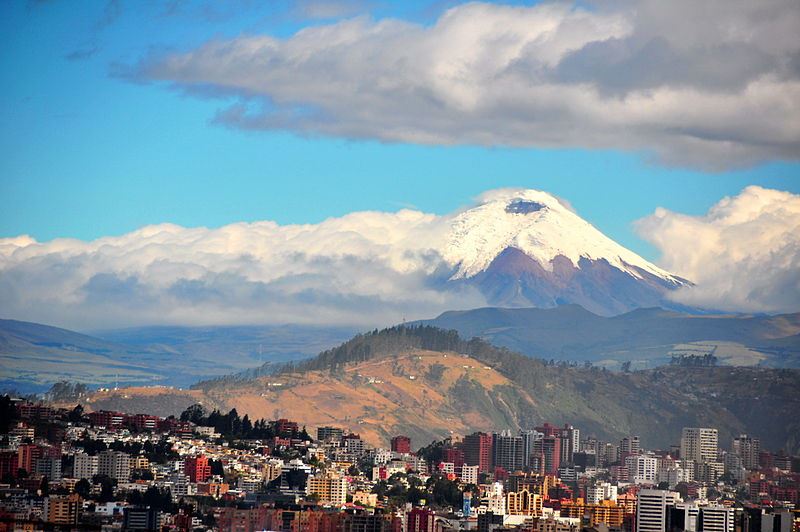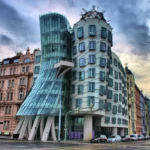Quito, the high-altitude capital of Ecuador, is a city rich in history, culture, and spectacular geography. Perched at about 2,850 meters (roughly 9,350 feet) above sea level in the Andes, it is one of the highest capitals in the world, and its blend of colonial heritage with modern living makes it a fascinating place to explore. Below is a comprehensive look at Quito—its past, its people, its customs, its quirks, and what makes it unique.
HISTORY OF THE CITY
The land upon which Quito now sits has been occupied for thousands of years by indigenous peoples, notably the Quitu tribe, from which the city likely gets its name. The region later became part of larger Andean cultures, including the Inca Empire, which extended its influence into what is now northern Ecuador in the 15th century. The Incas established administrative centers and built roads connecting Quito with their other holdings.
Spanish conquistadors arrived in the mid-1500s. In 1534, Sebastián de Belalcázar formally founded the city of San Francisco de Quito. Under Spanish colonial rule, Quito became an important administrative and religious center, known for its churches, monasteries, and indigenous craft traditions. It was elevated to the status of a Royal Audience (Audiencia) and later became part of the Viceroyalty of Peru and then the Viceroyalty of New Granada.
In the early 19th century, Quito played a significant role in the struggle for independence from Spain. On August 10, 1809, the city witnessed what is often called the “First Cry of Independence,” a movement that would ultimately lead to full independence for Ecuador in 1822. Since then Quito has been the capital of the Republic of Ecuador, undergoing periods of growth, modernization, and urban challenge, but always maintaining a strong link to its colonial past.
POPULATION
Today, Quito is home to around 2.8 to 3 million people in its metropolitan area, though the central districts have slightly lower densities due to their historic layout, parks, and public buildings. The city is diverse—mixing indigenous descendants, mestizos (people of mixed indigenous and European descent), Afro-Ecuadorians, and a growing population of international residents and immigrants. Urbanization has expanded Quito’s boundaries considerably, incorporating many neighborhoods and suburbs into its metropolitan zone.
The demographic profile is fairly young: many residents are under 30, and there is a lively energy in the streets, plazas, markets, and universities. Quito is also a city of migration; people from rural areas come seeking education, work, and better services, which shapes cultural life, social dynamics, and the urban landscape.

LANGUAGE
The official and dominant language in Quito (and Ecuador in general) is Spanish. However, the influence of indigenous languages remains alive, especially Kichwa (one of the Quechua languages), spoken by indigenous communities in surrounding areas and in certain urban neighborhoods. Many Kichwa speakers are bilingual, speaking both Kichwa and Spanish. In tourist zones, you will also find people who speak English, particularly those working in hotels, tour agencies, shops, and restaurants that cater to visitors.
CURRENCY
In an interesting twist of history, since the year 2000, the currency of Ecuador (and hence Quito) has been the U.S. Dollar (USD). This change was made in response to severe economic crisis and inflation; adopting the U.S. dollar helped stabilize prices and banking systems. Thus, you will use U.S. coins and paper bills in all everyday transactions—although sometimes local businesses will accept (or require) small change in Ecuadorian cents for certain goods. Prices are often given in whole dollars or with cents, and people are accustomed to thinking in terms of dollars and cents.
TYPE OF ELECTRICAL CURRENT
If you’re planning a visit and bringing electronic devices, note that the electrical standard in Quito is 120 volts at 60 Hz. The plugs used are of types A and B—i.e., the same style as in much of North America (two flat parallel pins, sometimes with a grounding pin). If your devices are built for 220–240 volts, you will need a voltage converter, or better, ensure you have dual voltage equipment. Power outages occasionally happen, especially in more remote areas or during storms, though the central city is fairly reliable.
CLIMATE
Because Quito straddles the equator while also being high in the Andes, its climate is fascinating and somewhat unique. Rather than having the four seasons of temperate climates, Quito’s weather is more defined by wet/dry periods and altitude.
- Temperature: Days are generally mild, often between about 15°C to 22°C (59°F to 72°F). Nights can get chilly, especially outside the city center or in higher-elevation neighborhoods.
- Rainfall: There are rainy seasons and drier patches. Rain is most likely between October–May, with often frequent afternoon showers. Dry season tends to run from June through September, though even in the dry months light rains or drizzle can happen.
- Altitude effects: The high elevation means the sun is strong (ultraviolet radiation is intense), and the air is thinner, so some people experience mild altitude-related symptoms (slight shortness of breath, fatigue) until they acclimatize.
- Microclimates: Depending on which side of the city you’re on (western vs eastern slopes), you may experience more cloud cover or more sunshine, more moisture from mountain slopes or more dryness.
TYPICAL FOOD
Quito offers a rich culinary tradition that combines indigenous ingredients with Spanish, Andean, and even Afro-Ecuadorian influences. Some typical foods you should try:
- Locro de papa: A hearty potato soup, made with local Andean potatoes, cheese, sometimes avocado, and often flavored with onions and garlic.
- Fanesca: A special soup eaten during Holy Week (Easter), made with a blend of grains, legumes, and fish; rich and symbolic.
- Ceviche: While more commonly associated with coastal Ecuador, Quito has great ceviche—typically using shrimp, fish or mixed seafood, marinated with lime, onion, cilantro, and often with popcorn or toasted corn (choclo).
- Hornado: Slow-roasted pig, commonly served with corn, potatoes, plantain, and salad.
- Empanadas de viento: Fried turnovers filled with cheese and sprinkled with sugar—light, airy, often eaten as a snack or breakfast item.
- Helado de paila: A traditional, hand-churned ice cream made over a cold metal pan, using fruit juices; you’ll often find fruit flavors like mora (blackberry), naranjilla, or taxo.
Street food and markets are also great places to try local fruits, fresh juices, and smaller dishes—locally grown coffee is excellent as well.
TRANSPORT
Getting around Quito can be a mixed experience: fascinating, sometimes challenging, but usually manageable.
- Public buses: These are the backbone of local transport. Quito has buses that cover nearly every neighborhood. They’re cheap (though crowded), and stops are frequent.
- Trole-bús and Metro: Quito has a Bus Rapid Transit (BRT) system known as the “Trole-Bús,” which runs on major avenues and helps bypass traffic congestion. Also, the metro line has been developed in recent years to help alleviate traffic and connect key parts of the city.
- Taxis and ride‑sharing: Taxis are common; you can hail them on the street or use apps. Ride‑sharing services operate here. In general, fares are modest by many international standards, though traffic can make trips longer than expected.
- Walking: In the historic center, plazas, markets, and parks, walking is often the best way to soak in the atmosphere. Streets are cobbled in many parts; elevation changes are common.
- Roads and traffic: Due to Quito’s terrain (mountains, hills, steep roads), driving can be slow, curving, and sometimes precarious. Traffic congestion during rush hours is significant in many parts, especially because of the city’s expansion and increasing car ownership.

SAFETY
Quito is safer than many large cities in Latin America, but like any urban area, it has its risks and areas to be cautious about. Some considerations:
- Pickpocketing and petty theft: More common in crowded places such as bus stations, markets, public transportation, and tourist hotspots. Keeping an eye on belongings, avoiding flashy jewelry, and being aware of surroundings helps.
- Neighborhood variation: Some neighborhoods are very safe and reasonably wealthy, with good lighting and low crime, while others (especially outlying or less centrally controlled areas) may have higher rates of crime. Locals often know which zones are safe at night and which aren’t.
- Traffic safety: Road safety is another concern. Pedestrians must be cautious crossing streets; drivers may be impatient; road conditions in some areas can be variable.
- Natural hazards: There are occasional landslides in rainy season, and because the city is in the Andes, geological issues and risk from volcanic activity are not unheard of (Quito is relatively close to volcanic zones).
- Health: At altitude, visitors may need time to acclimatize. Sun exposure is powerful; dehydration can happen faster than one expects. Healthcare in Quito is fairly good—hospitals and clinics are available, especially in the central city—but having travel insurance and being up to date on vaccinations is wise.
Generally, visitors who use common sense—avoid risky areas at night, don’t carry too much cash, stay aware—will usually have trouble‑free stays.
MAIN TOURIST ATTRACTIONS
Quito has many remarkable places to see. Whether you love history, nature, art, or unique cityscapes, there is something to captivate.
- Old Town (Centro Histórico) – A UNESCO World Heritage site, this is where the colonial heart of Quito beats. Narrow, cobbled streets, stately churches like La Compañía de Jesús (with its lavish gilded interior), the Cathedral, and monasteries. The plazas—Plaza Grande, Plaza San Francisco—and the ornate architecture are awe-inspiring.
- El Panecillo – A hill rising above the city center topped with a statue of an angel. From its viewpoint you get sweeping panoramas of Quito’s mix of colonial spires, modern buildings, and the mountains beyond.
- Mitad del Mundo – Literally “Middle of the World.” This is the site near the equator line where you can stand in the northern and southern hemispheres at once. There is a monument, a museum, and various exhibits about equatorial science and indigenous cultures.
- TelefériQo – A cable car ride up the slopes of the Pichincha volcano. Starting from the edge of the city, it takes you up high into moody skies and cloud forests. Once at the top, there are hiking opportunities, viewpoints, possibly even snow in some conditions, depending on weather.
- La Ronda – A charming, narrow street in Old Town, where artisans, musicians, small cafes, and traditional restaurants line the way. It captures much of Quito’s soulful and artistic side.
- Guápulo – A neighborhood built on a steep hillside, combining lush nature with old architecture. Many visitors hike or drive to Guápulo to enjoy views, galleries, restaurants, and peaceful walks.
- Museums – There are several: art museums, history museums, and specialized ones like the Museo de la Ciudad, offering insight into Quito’s path through time; also museums of indigenous culture, colonial art, and natural history.
- Parque La Carolina – A large urban park, popular for jogging, sports, picnics, and social gatherings. Provides green relief from the more densely built city.
OTHER IMPORTANT ASPECTS
- Economy and commerce: Quito is an administrative, political, and commercial hub. Many governmental functions are there, so public administration plays a big role. Tourism is also important; foreign visitors come for heritage, nature, and to use Quito as a gateway to the rest of Ecuador. There is growing investment in tech, services, and education.
- Architecture and urban layout: The historic core preserves colonial and baroque-era buildings; outside it, the city expands in a sometimes haphazard way. The terrain causes expansion to be uneven—some neighborhoods cling to steep hillsides; others sprawl on flatter land. Earthquake-resistance and infrastructure maintenance are ongoing concerns due to geology and slope.
- Culture, arts, and festivals: Quito has vibrant festivals—religious processions, carnival, music, and dance. Traditional arts and crafts (textiles, stone carving, goldsmith work) are alive. The city is known for its gastronomy, cafés, street food, and an emerging culinary scene that blends tradition and innovation.
- Environmental issues: Pollution, especially air quality in the dry season when thermal inversions trap smog, is a concern. Also, water supply and waste management are challenges as the city grows. Maintaining the balance between growth, preserving historic districts, and protecting nature (mountains, green belts around the city) is a central discussion.
- Altitude and health caution: As mentioned, Quito’s high elevation can lead to altitude sickness for visitors not accustomed. Resting, staying hydrated, avoiding heavy meals right away, and giving oneself a day or two before strenuous activity is advisable.
- Connectivity: Quito has a modern international airport which connects it to many cities in the Americas and Europe, acting as a gateway. Once in the city, infrastructure for internet, banking, tourism services is well‑developed in central areas.
Quito is a city of contrasts: both ancient and modern, high and steeped in valley, colonial stone churches next to bustling markets, indigenous rhythms alongside cosmopolitan cafés. Its history is deep; its people are warm; its landscapes are breathtaking; its challenges are real but so are its opportunities. If you venture there with curiosity, respect, and a willingness to slow down and adjust to altitude and pace, Quito can be a truly enriching experience—one that lingers in memory long after one departs.


